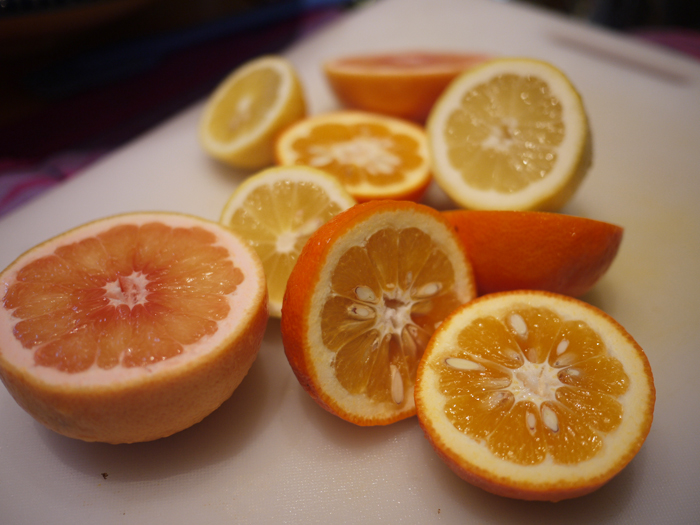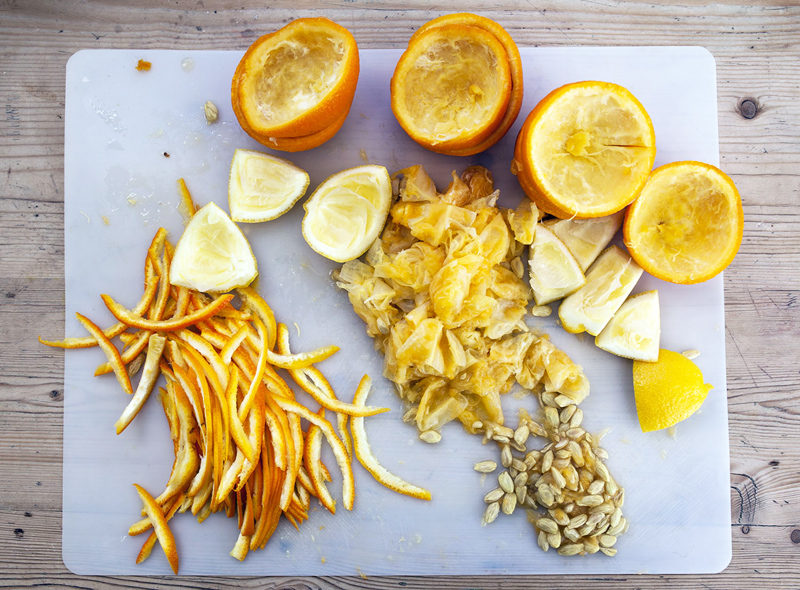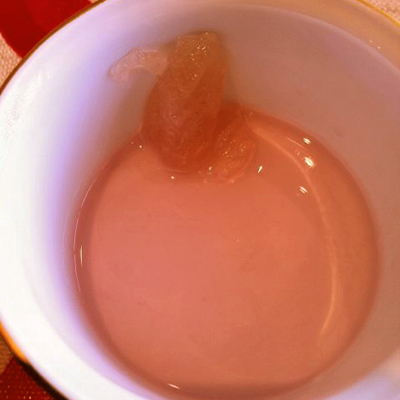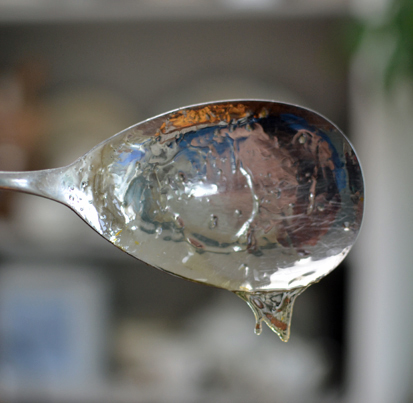Making marmalade is one of the most rewarding preserves to make  and it takes time to create
brightly coloured jars with evenly suspended shreds of citrus peel. The traditional Marmalade recipe I use involves, an hour and a half to prepare, an overnight soak for the juice, peel and muslin bag in water. The next day, at least two hours simmering in a covered pan, followed by a fast boil with the sugar dissolved in an un-lidded pan, potting the marmalade and not forgetting the washing up.
and it takes time to create
brightly coloured jars with evenly suspended shreds of citrus peel. The traditional Marmalade recipe I use involves, an hour and a half to prepare, an overnight soak for the juice, peel and muslin bag in water. The next day, at least two hours simmering in a covered pan, followed by a fast boil with the sugar dissolved in an un-lidded pan, potting the marmalade and not forgetting the washing up.
The Marmalade recipe
If the proportions of fruit, acid, pectin, water and sugar in your pan are not balanced, the marmalade will be unlikely to set. Nine times out of ten, marmalade fails to set if the recipe does not have a precise weight of ingredients. Listing a number, e.g 4 Grapefruits will mean a variable weight. Supermarket grapefruits vary in weight considerably, variations in weight also apply to oranges and lemons. It’s worth noting that marmalade is made from citrus fruit and not a combination of citrus and other fruit. Apart from contravening the regulated definition of the product marmalade, combining citrus and other food, sets the preserver up for making a preserve that is very different from marmalade.
The weight of sugar in a traditional marmalade is twice the weight of fruit for a balanced flavour. To readers who question the weight of sugar, I suggest ( as with all good things) moderation in consumption. The trend to add equal quantities of sugar to fruit will delay the set, as it will need boiling for a long time, which will often compromise the flavour.
Preparation
 It is important to use all of the fruit when preparing it before cooking. Once the fruit has been juiced, I remove only the inner membranes from the fruit, to be chopped and tied up in a muslin bag with the pips. Many of the muslin squares sold in cook shops are too small, they should ideally be at least 36cm square. The white pith of Seville oranges and Grapefruits clears once cooked so there is no need to remove it. If pith is discarded, the balance of the recipe will be compromised, affecting the set as pith is an invaluable source of pectin.
It is important to use all of the fruit when preparing it before cooking. Once the fruit has been juiced, I remove only the inner membranes from the fruit, to be chopped and tied up in a muslin bag with the pips. Many of the muslin squares sold in cook shops are too small, they should ideally be at least 36cm square. The white pith of Seville oranges and Grapefruits clears once cooked so there is no need to remove it. If pith is discarded, the balance of the recipe will be compromised, affecting the set as pith is an invaluable source of pectin.
Once the ingredients are in the pan, lift up the muslin bag and measure the liquid with an upright wooden spoon and mark the level of the liquid on it ( this is best done with a sharp knife). Next, divide and mark the depth into three equal sections. The spoon will be your guide, letting you know when the contents of the pan are sufficiently reduced.
Reducing the Volume
Before the sugar is added, the other ingredients are simmered very gently in a covered pan. The contents of the pan need to be reduced by a third. If the contents are not reduced sufficiently, too much water will be left in the pan and that will affect the set. With excess water, a long boil will follow after the sugar is added and the set will be elusive. Once the volume has been reduced the proportions of fruit, pectin and acid should be in harmony, ready to add the sugar.

If you are uncertain this is the case, a pectin test may help. Remove 1 teaspoon of the liquid from the pan. Pour the liquid into a small cup or ramekin. Add 1 tablespoon of methylated spirit to the cup or ramekin and swirl the contents together. A jelly lump will form when plenty of pectin is present. If the pectin content is medium, the lump will look more like an amoeba. If there is too little pectin, the clot will be broken down into a number of small blobs. Reducing the volume further should improve the pectin content.
Sugar
There are a number of different sugars popular in marmalade recipes. I like Tate & Lyle’s granulated cane sugar as it gives a bright colour and an excellent set, beautifully gelled. I have tried using caster sugar and granulated beet sugar and the marmalade tends to be cloudy. Reducing the sugar in the recipe means a slacker, not set consistency and the marmalade could have a shorter shelf life. The trend normalising “soft set” as acceptable is a misleading way of saying the marmalade is set. The correct consistency is gelled, similar to a that of a jelly preserve. If the consistency is runny or rigid, it’s not marmalade.
I am often asked about Preserving and Jam Sugar. Preserving Sugar is much more expensive than granulated and I find it does not improve the product. Jam Sugar has added pectin which should not be required for marmalades.
Boiling to a set
I always make small batches of marmalade, using 675g of fruit. Once the sugar is dissolved, a boil to a set takes an average of 5-7 minutes. Prolonged boiling times, up to 30 minutes, a common recommendation in food magazines often results in syrupy, caramelised marmalade, a ruined pan and evidence of an unreliable recipe. A full rolling boil is hard to stir down and looks like foaming Coca-Cola. Without a full rolling boil, marmalade will struggle to set. So it is important to use a large enough pan, so that there is little risk of the marmalade boiling over. An ideal pan has a height that is less than the circumference , for example 18cm high 26cm circumference.
A Set

A well set marmalade should set in the jars and be ready to eat within hours and the process starts as soon as setting point is reached.
There are three popular ways of testing for a set, using a plate, a thermometer or a spoon. I would like to see the plate test confined to history as it is the most distracting test. Assuming I remember to put a plate to go cold in the fridge, I leave a spoonful of the marmalade on the plate while I wait for it to wrinkle when I push it with my finger. Meanwhile, what to do with the boiling mass of marmalade? Turning off the heat kills the temperature, leaving it to boil will boil away flavour. I have used a range of thermometers including digital and often the readings under or overset the marmalade.
My preferred test is the flake test. Dip a large spoon into the pan and scoop out a spoonful. Lift the spoon above the pan and turn it horizontally. If the marmalade has reached setting point of 104.5C (220F) it will drip then hang or sheet on the side of the spoon, rather like a small fragment of stained glass. This test is quick and confirms my view that all the tests for setting can be done inside the pan with a spoon.
Just before potting up the marmalade, if you carefully drag your spoon across the surface of the marmalade you will see a wrinkle, another sign of setting. Also if you depress the back of the spoon gently on the surface of the marmalade, it should feel slightly dense and resistant.
For a good set, choose a traditional marmalade recipe based on science.
For similar guidance concerning Jam Recipes click here
More details of How to make Marmalade or First Preserves: Marmalades – Jams – Chutneys
